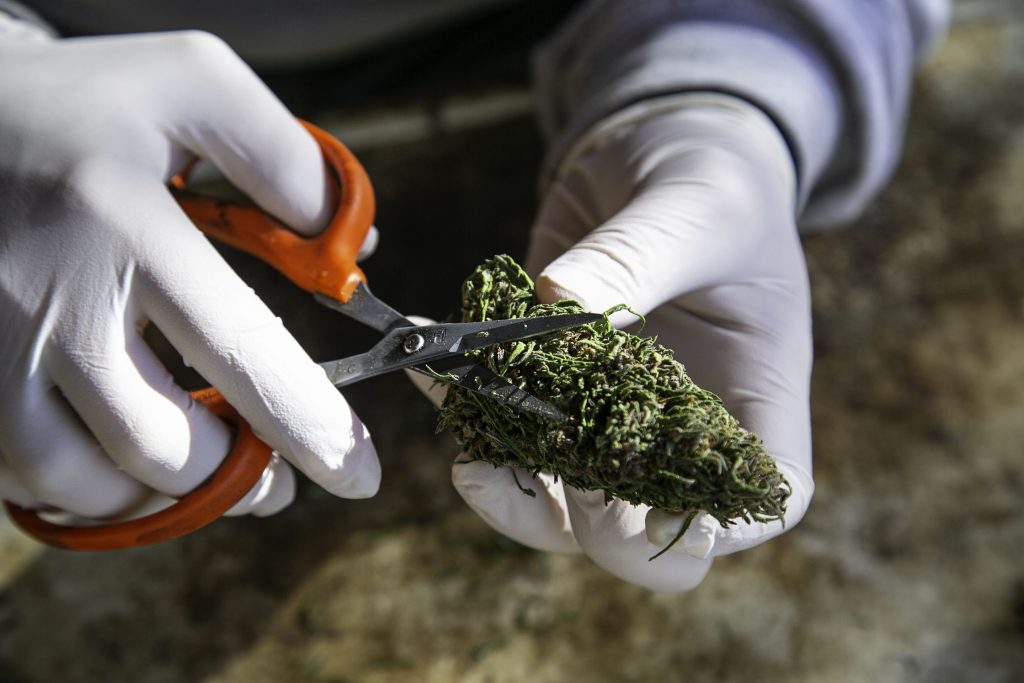
Features
Cultivation
Production
Vantage Point: Tips for an effective post-harvest
October 25, 2021 By Matthew Buccioni and Troy Henderson
 Photo: Jantira/Adobe Stock
Photo: Jantira/Adobe Stock Licensed producers (LPs) know that the post-harvest period is critical in producing high-quality cannabis. Unfortunately, this time can also be a window of opportunity for the spread of infection. Contaminated hands, surfaces and tools can carry pathogens from one plant to the next, threatening the health of your yield. Cleaning and disinfection during post-harvest are among the most important steps you can take to protect plants from disease, allowing your hard work to pay off.
Start with a clean slate
After harvesting and removing all of the plants and large debris from the room, perform a deep clean of all your production areas. For cannabis facilities, clean and disinfect surfaces that may transmit pathogens from one plant to another, including equipment like trimmers, potting materials or scales, as well as large surface areas.
‘Cleaning’ and ‘disinfecting’ are often used interchangeably, but are two separate parts of a successful infection control program. ‘Cleaning’ is the process of physically removing dirt and debris from a surface (resin and other organic soils). While this might lift pathogens off the surface, it doesn’t necessarily kill them – that’s where disinfection comes in. ‘Disinfecting’ means destroying pathogens, whether you are dealing with fungi, bacteria, or even viruses that can threaten the health of your team and crop.
In your facility’s effort to remain compliant and eliminate pathogens, cleaning and disinfection work hand-in-hand: the cleaning process removes soils on the surface, allowing the disinfectant to kill pathogens left behind. Choosing a one-step cleaner-disinfectant formulated with detergents can enable you to clean and disinfect simultaneously, saving considerable time and effort. Many commonly used chemicals like bleach and isopropyl alcohol do not have detergency properties. They may not be effective unless the surface is pre-cleaned with a separate detergent product, adding significant time and cost to the process.
Invest in the right tools for the job
Choosing the right tools can make all the difference in cleaning and disinfection. For example, if your disinfectant is concentrated and needs to be diluted before use, setting up an automated dilution system can help you quickly prepare the correct concentration, saving time while reducing the risk of user error such as improper dilution.
When it comes to applying your disinfectant, the tools you’ll need depend on the area within your facility. In general, foaming applications allow you to cover large areas with less product, leading to cost savings in the long run. For larger surfaces, like grow tables or walls, a hose-end or pump-up foamer can help quickly cover a wide area with the disinfectant. For smaller surfaces, pre-moistened disinfectant wipes or spraying with a foaming trigger sprayer are ideal to disinfect quickly, with little effort.
If you are dealing with stubborn resins and soils that are proving to be a challenge to remove, try using warm/hot water to dilute your concentrated disinfectant or cleaning product. Warm water can enhance the cleaning abilities of detergents and surfactants, which help lift and remove stubborn soils such as resins or salt stains. Check with your chemical and equipment manufacturer to ensure compatibility with higher temperatures.
Put quality control first
Pathogens on surfaces are mostly invisible to the naked eye. The first sign that something is wrong with your protocols could be a disease outbreak! Implementing a few basic quality control procedures can help ensure that your protocols are doing their job and stop a potential outbreak. For instance, keeping logs for cleaning and disinfection is a great way to ensure that no critical surfaces get missed. In addition, if you are using secondary bottles to apply your disinfectant, workplace labels can be used to mark the expiry date of the solution, so they are not used.
Many LPs use environmental monitoring to evaluate the cleanliness of key surfaces after cleaning and disinfection. A highly common method is adenosine triphosphate (ATP) bioluminescence, which detects the presence of organic contamination on surfaces. This could be from pathogens and other organic materials left behind. While ATP testing can provide a helpful snapshot a surface’s overall cleanliness, you may need to pair it with microbiological swabbing methods to detect the presence of certain pathogens on the surface. It’s also essential to work with your device manufacturer to set a baseline whenever switching to a new disinfectant, as each can uniquely interact with the ATP system.
Post-harvest is an exciting time, but don’t let your guard down and allow pathogens to strike. Vigorous cleaning and disinfection protocols during this time are more critical than ever to protect your yield.
Matthew Buccioni is the infection prevention and biosecurity specialist at Virox Technologies Inc.
Troy Henderseon is an account executive and LP consultant at Virox Technologies Inc. Virox is the creator of SHYIELD disinfectants.
Print this page